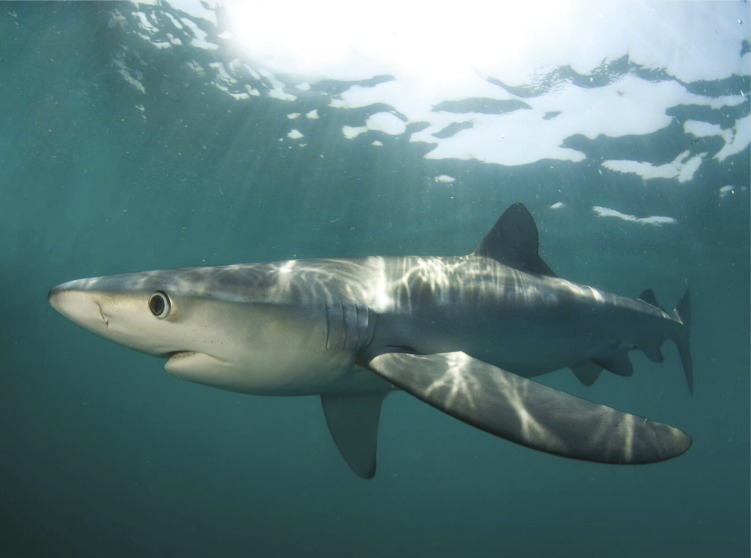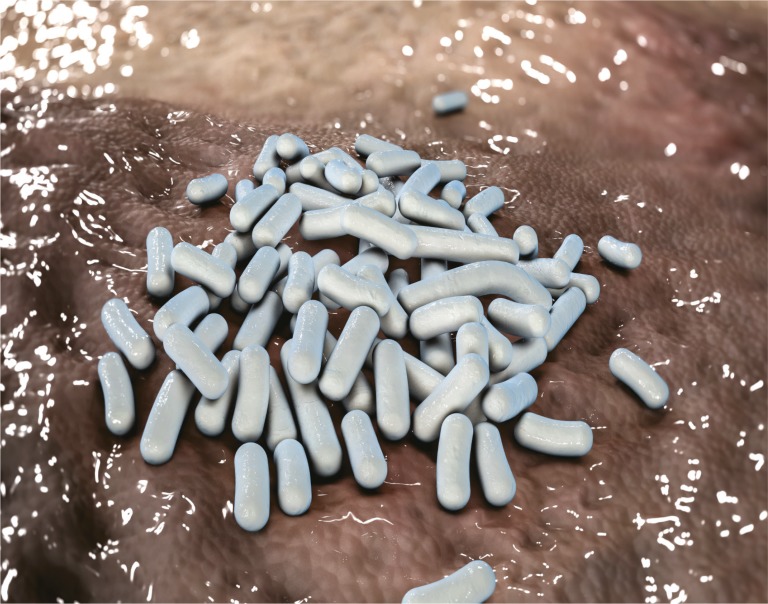Overlap of shark and fishing vessel ranges
Blue sharks (Prionace glauca) are among the most heavily exploited pelagic fishes in the ocean.
Tens of millions of ocean-dwelling sharks are caught by fishing vessels each year. Although catch rates have declined significantly for many shark species, oceanic shark fishing remains largely unregulated. A lack of data on where sharks are likely to encounter fishing vessels hampers current conservation efforts. Nuno Queiroz et al. (pp. 1582–1587) tracked more than 100 sharks from six different species by satellite in the North Atlantic. Within each species’ preferred ranges, sharks tended to aggregate in locations characterized by strong temperature gradients and high productivity. Concurrent with shark tracking, the authors tracked 186 Spanish and Portuguese longline fishing vessels using GPS and found that the fishing vessels and sharks targeted similar locations. For the most heavily fished shark species, blue and mako, about 80% of the sharks’ tracked ranges overlapped with the fishing vessels’ ranges. Areas of highest overlap included the Gulf Stream, the North Atlantic Current/Labrador Current convergence zone near Newfoundland, and along the Mid-Atlantic Ridge southwest of the Azores. Over the period 2005–2009, overlap between sharks and fishing vessels persisted between years in these locations. According to the authors, current hotspots of shark activity are at risk of overfishing, and introduction of catch quotas might be necessary to protect oceanic sharks. — B.D.
Native American losses and climate change
The Jemez Valley of New Mexico, home to 6,500 Pueblo Indians in 1620.
The arrival of Europeans in North America heralded dramatic declines in Native American populations. One theory holds that this demographic shift reduced biomass burning and regenerated forests, thereby contributing to the period of global cooling known as the Little Ice Age. To constrain the relationship between Native American losses and climate change, Matthew Liebmann et al. (pp. E696–E704) constructed population estimates through time for the Jemez Province of New Mexico by using a combination of remote sensing techniques, archaeological data, tree-ring chronologies, and historical records. The investigation revealed that the indigenous people of the Jemez pueblos suffered a drastic and rapid collapse, affecting around 87% of the population, but not until roughly a century after initial European contact. Furthermore, because their demise likely spurred new tree growth, extensive forest fires occurred more frequently between 1640 and 1900. As with other recent studies, the findings demonstrate that population declines among indigenous North Americans followed different trajectories in the aftermath of European colonization and caution against simple inferences about the climate impact of human fire use, according to the authors. — T.J.
Expediting intraoperative analysis of brain tumors
DESI-MS and tissue smears for glioma characterization.
Desorption electrospray ionization mass spectrometry (DESI-MS) is a lipid-based analytical technique used during surgical removal of brain tumors to distinguish cancerous tissue from healthy brain parenchyma, which is composed of neurons and glia. However, current techniques require tissue freezing and sectioning before analysis, prolonging surgery and posing safety risks. Alan Jarmusch et al. (pp. 1486–1491) used DESI-MS and statistical methods to distinguish healthy gray and white matter from gliomas, meningiomas, and pituitary tumors in a cryopreserved collection of around 700 samples from 58 patients; the method’s sensitivity and specificity were greater than 97% and 98%, respectively. The tumor metabolites 2-hydroxyglutaric acid and N-acetylaspartic acid helped delineate glioma margins from brain parenchyma, which is often infiltrated by fingerlings of gliomas in certain types of aggressive brain tumors. Individual tumor types could be identified with sensitivity and specificity greater than 99%. To sidestep freezing and sectioning tissues before analysis, the authors used a 3D-printed device to uniformly smear around 50 mm3 of tumor tissue into a roughly 100-µm-thick layer on a glass slide, and found similar lipid and metabolite profiles and intensities in the tissues to those obtained through cryosectioning. Thus, tissue smearing might help expedite analysis and abbreviate surgery. According to the authors, tissue smearing and DESI-MS might together offer a valuable clinical expedient for molecular characterization during cancer surgery. — P.N.
Rodent–human chimeras for disease modeling
Human embryonic stem cell-derived NCCs (green) contribute to mouse embryo at day 10.5 (A), cranial region (B), and trunk coat color in postnatal mice (C).
Stem cell-derived human cells maintained in short-term laboratory cultures are considered imperfect models of slowly progressive ailments, such as Alzheimer’s and Parkinson’s diseases, which are marked by the gradual buildup of cellular changes. Malkiel Cohen et al. (pp. 1570–1575) induced mouse, rat, and human pluripotent stem cells to generate neural crest cells (NCCs), a multipotent cell type that develops within the nascent epidermis of embryos and engenders melanin-producing skin cells. The authors injected the NCCs into 8.5-day-old embryos growing in the uterus of albino mice, thus creating hybrids, including rodent–human chimeras. Regardless of the source, the NCCs slid under the developing mouse epidermis, migrated deep into the embryos, and generated functional pigment cells, as evidenced by offspring coat colors. Compared with primary NCCs, however, those generated in vitro were less efficient at contributing to offspring pigmentation. Similarly, NCCs derived from induced pluripotent stem cells generated from skin cells of an African American donor influenced offspring coat color, albeit to a smaller extent than mouse NCCs. Experiments using recipient mice carrying a mutation that hobbles melanocyte formation suggested that the reduced ability of human NCCs derived from stem cells to influence offspring pigmentation might be ascribed to competition from the hosts’ melanin-producing cells. According to the authors, interspecies chimeras represent a powerful tool to study stem cell-derived, patient-specific cells in human diseases. — P.N.
Genetic history of present-day Indians
Genetic history of present-day India. Image courtesy of iStockphoto/selimaksan.
Researchers have previously suggested that mainland India’s current population largely descended from two ancient groups, namely ancestral north and south Indians. Analabha Basu et al. (pp. 1594–1599) analyzed genome-wide variations from 367 unrelated Indians belonging to 20 ethnic groups, including two tribal groups from the outlying Andaman and Nicobar Islands, as well as data from the Human Genome Diversity Panel, a repository of genomic data representing hundreds of people worldwide. In addition to ancestral north and south Indians, the authors discovered two major ancestries for mainland Indians: the Austro-Asiatic and Tibeto-Burman ancestries. Unlike mainland Indians, the hunter-gatherers of the Andaman archipelago likely share ancestry with present-day Pacific Islanders, representing a fifth ancestry in India. Gene exchange was widespread among ancestral groups but replaced by endogamy, particularly among upper-caste Indo-European speakers, around 70 generations, or 1,575 years, ago; the timing coincides with the reign of the Guptas, whose ruling Hindu elite espoused and enforced Vedic Brahminism, a religion that includes social strictures against marriage between castes. In contrast to a previous analysis that concluded that only two ancestral lineages contributed to Indian ethnic groups, the current study includes a more geographically and culturally representative sample to furnish a granular view of India’s current genomic diversity and of the peopling of the subcontinent, according to the authors. — P.N.
Antibiotic treatment and antiviral immunity
Bacterial imbalance and antiviral immunity. Image courtesy of iStockphoto/Svisio.
The human vaginal tract harbors a wealth of Lactobacillus species, which maintain an acidic environment and produce hydrogen peroxide to counter pathogenic bacteria. Ji Eun Oh et al. (pp. E762–E771) tested whether imbalances in the vaginal microflora triggered by antibiotic treatment impairs immunity against genital herpes, an infection caused by herpes simplex virus type 2 (HSV-2). Compared with mice administered distilled water, mice treated with a mix of five oral antibiotics for 4 weeks were less successful at combating intravaginal HSV-2 infection, displaying more severe pathology, higher vaginal viral titers, and marginally increased mortality. Though it did not affect innate immune response as measured by levels of proinflammatory cytokines, antibiotic treatment altered the composition of vaginal bacterial communities, notably inducing a rise in Gram-negative Proteobacteria to the detriment of Lactobacillus. Antibiotic treatment was also tied to increased vaginal secretion of IL-33, a cytokine that impairs migration of effector T cells to infection sites in the vaginal mucosa and tamps down local antiviral immunity by diminishing levels of the cytokine IFN-γ, a staple of human antiviral defense; experiments with recombinant IL-33 corroborated the findings. Heightened IL-33 levels were likely induced by protease-producing bacteria, which grow profusely in the presence of oral antibiotics. According to the authors, antibiotic-induced disruptions of microbial balance in mucosal surfaces might influence human antiviral immune defense. — P.N.








